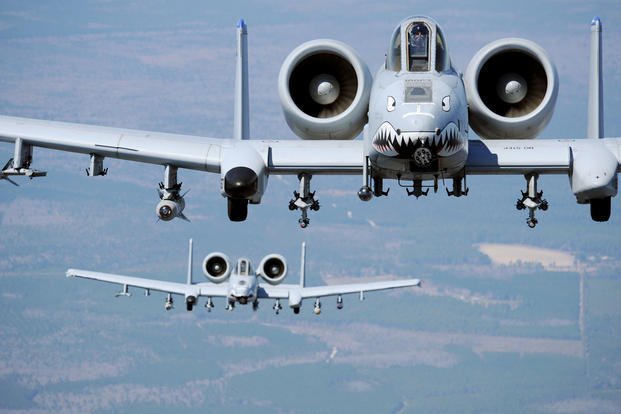With congressional members rejecting the U.S. Air Force’s plans to make substantial cuts to some of its oldest aircraft fleets, the service will put its plan to shift some close air support aircraft to Arizona on hold as it figures out other options.
Last month, the service said it would move some A-10 Thunderbolt II aircraft and HH-60 Pave Hawk helicopters to Davis-Monthan Air Force Base to consolidate close air support and rescue operations while retiring some of the oldest Warthogs in the fleet. Specifically, 14 aircraft that are used for an A-10 weapons course and test and evaluation would relocate from Nellis Air Force Base, Nevada, to the base in Arizona in 2022. The move was predicated on Congress approving the Air Force's 2022 budget request to get rid of 42 A-10s -- an attempt the service has tried before, but to no avail, because lawmakers shot it down.
Lawmakers would block the retirement of the A-10s again if the recent Senate Armed Services Committee’s version of the bill becomes law, prompting a pause in the plans to move the 14 aircraft, the service announced last week.
Read Next: Down to the Wire, the Senate Has a Deal to Fund the National Guard
Air Force officials have said the service can modernize and maintain 218 of the 281 tank-shredding aircraft it currently has, downsizing from nine operational squadrons to seven by 2023. The service already had singled out 35 A-10s at Davis-Monthan from the projected 42 it wants to retire amid the consolidation effort, with other aircraft out of the 281 to maintain for backups or testing.
In addition to getting rid of A-10s in the budget request, the Air Force outlined plans to retire 48 F-15C/D Eagles; 47 F-16 Fighting Falcons; 14 KC-10 Extenders; 18 KC-135 Stratotankers; 20 of the oldest C-130 Hercules transport or special mission aircraft models; 20 RQ-4 Global Hawk drones; and four E-8 Joint Surveillance Target Attack Radar System (JSTARS) aircraft, used for battlefield command-and-control.
The C-130 cuts are part of a larger goal to reduce its Hercules fleet to 255 aircraft over the next few years from about 300 currently. Of those 255, 163 would be newer J-models the service already has or are on order from Lockheed Martin; the Air Force would upgrade 92 older H models to keep them from becoming outdated.
Here’s how lawmakers intend to rein in the Air Force’s projected cuts to its remaining aircraft fleets, and where they intend for the Air Force to expand:
- The Senate Armed Services Committee would allow for the retirement of 18 KC-135 aircraft and 12 KC-10 aircraft -- two fewer than the service’s request.
- The SASC said the Air Force must maintain a total active aircraft inventory of 292 C-130 aircraft; in its markup, the House Armed Services Subcommittee on Seapower and Projection Forces stipulates it should retain a minimum of 287 C-130 aircraft.
- While the SASC says it will extend “the requirement to maintain a minimum capacity of Air Force fighter aircraft,” it did not detail how this would affect the F-15 or F-16 prospective cuts outlined in the Air Force’s original request.
- The service wants to increase its fourth-plus generation inventory of F-15EX Eagle II fighters, which entered service this spring, by 12 aircraft. The SASC gives the Air Force the option to purchase five additional F-15EX aircraft.
- Similar to its requests in the 2019-2021 budgets, the Air Force wants 48 fifth-generation F-35A Joint Strike Fighter aircraft. SASC will allow for one additional F-35A despite years of giving the service the option to buy up to 12 jets more.
- While lawmakers have yet to detail what the Air Force should do with its RQ-4 Global Hawk drones and E-8 surveillance aircraft, the House Appropriations Committee wants to give the Air Force six additional MQ-9 Reaper drones. The Air Force revealed in its previous 2021 budget submission that it would not buy any more MQ-9s, phasing out the production line in 2022. However, the latest budget accounts for an increase of 21 drones it bought in previous years to cap its inventory at 351.
-- Oriana Pawlyk can be reached at oriana.pawlyk@military.com. Follow her on Twitter at @oriana0214.
Related: In New Realignment, Air Force Wants to Shift Some HH-60s, A-10s and F-22s














